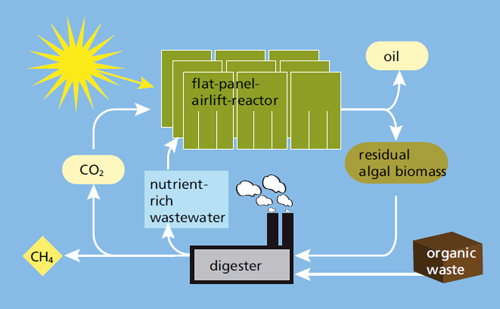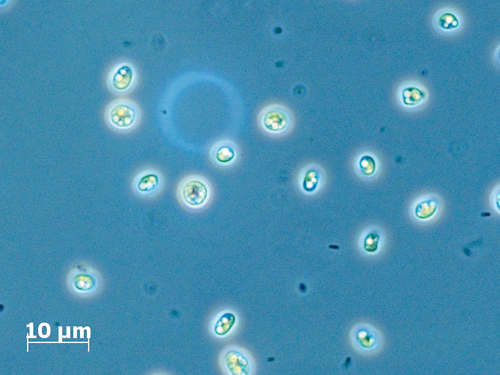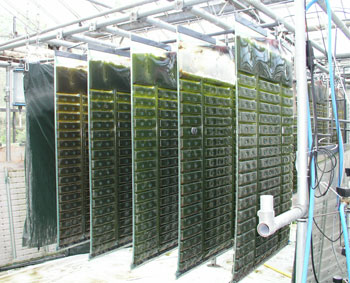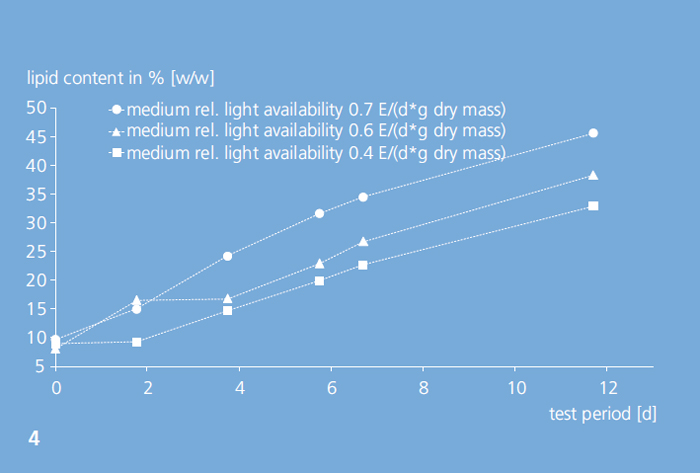Currently, biofuels are mainly produced from plant-based raw materials, for example biodiesel from rapeseed or palm oil. In Germany the arable land will no longer be available for food production; in Southeast Asia rainforests are being cleared for oil palm plantations. The high water consumption during the cultivation of land plants for the production of biofuels is also viewed critically. Moreover, the current production capacity and area available for this purpose cannot meet the demand for renewable resources for biofuels.
Lipid-rich algae biomass as a regenerative energy-source
Sustainable energetic use of microalgae

Biodiesel from microalgae represents an alternative to present-day biofuels. Compared with cultivating higher plants, the cultivation of microalgae has a considerable number of advantages. These include a higher productivity, reduced water consumption and the possibility of cultivating algae on land that is not suitable for agricultural purposes. At present we are examining a concept for the sustainable energetic use of microalgae within the framework of the research project EtaMax. Integrated in a cycle of materials and energy streams, algae biomass is produced from flue gas and wastewater streams (see diagram). Microalgae are cultivated autotrophically, solely by using sunlight. Oil produced from algae can be used as energy source and the resulting exhaust gas is returned to the process. The remaining biomass is fermented to produce biogas. This process permits high-quality biomass to be created from waste streams and the complete energy recovery of the biomass.
Requirements for the biomass and production process

The prerequisite for the economical use and an efficient downstream process of the algae biomass is a high lipid content. Furthermore, the spectrum of fatty acids should have a high proportion of saturated and monounsaturated fatty acids, as polyunsaturated fatty acids reduce the storage stability of the algae oil. The enrichment of fatty acids in the form of triglycerides can be induced by a nitrogen limitation of the microalgae culture. The triglycerides are deposited inside the cells as storage molecules (see picture). In laboratory experiments at the Fraunhofer IGB we were able to achieve lipid contents of up to 70 percent [w/w] under permanent artificial light.
When producing algae as energy source, it is necessary to transfer this process into an outdoor cultivation process. Here the challenge is to establish a process that runs well and remains stable under varying outdoor conditions, and also generates biomass with a high lipid content. It has to be taken into account that the recurrent day-night rhythm and changing weather conditions result in a variable process temperature and different light intensities.
Outdoor plant for lipid production

In 2010 and 2011 we operated an outdoor pilot plant with five south-facing 30-liter flat-panel airlift reactors to characterize the lipid production process with the microalgae Chlorella vulgaris. A two-stage batch process was established. Biomass was produced in a first growth phase from four to seven days with an optimum supply of nutrients. This was followed by the lipid production phase, in which the algae cells enriched lipids by means of nitrogen and phosphate limitation. The focus of the investigation was to maximize the lipid content of the algae and to determine a quantitative correlation between the relative light intensity and the biomass concentration in the reactor. The relative light intensity describes the ratio of light input to biomass concentration in the reactor and is specified as Einstein (1 mole of photons) per gram of dry mass and day.
Factors influencing the lipid content

We succeeded in establishing a stable process under outdoor conditions, permitting the production of algae biomass with a very high lipid content. Thus with Chlorella vulgaris we were able to achieve a maximum lipid productivity of 0.3 g fatty acids / (L*d) in the outdoor pilot plant. It became clear that the flat-panel airlift reactor used here, which was developed several years ago at the Fraunhofer IGB, is ideal for this process. From the literature it is known, for example, that the cultivation of microalgae in photobioreactors developed and operated in Italy leads to a maximum lipid productivity of only 0.2 g fatty acids / (L*d) [1].
We determined the influence of the relative light intensity on the lipid content of the biomass by the parallel operation of flat-panel airlift reactors, each with different biomass concentrations. We were able to show that high lipid contents of over 45 percent [w / w] are achieved with a low dry mass concentration and related high relative light intensities.
Outlook
Making use of the results generated under outdoor conditions, the high lipid content of the biomass can be selectively adjusted by means of process management. A defined, consistent quality of the biomass with high lipid content provides the ideal basis for the development of a downstream process to obtain biodiesel from algae. Working on the basis of these experiments the aim is to make the production process viable at the industrial scale and to further reduce the production costs.
Literature
[1] Rodolfi, L. et al. (2009) Biotechnology and Bioengineering 102(1): 100-12
Project partners
- Daimler AG
- EnBW Baden-Württemberg AG; FairEnergie GmbH
- Fraunhofer Institute for Process Engineering and Packaging IVV
- Karlsruhe Institute for Technology (KIT)
- Netzsch Mohnopumpen GmbH
- Paul Scherrer Institut PSI
- Stadt Stuttgart
- Stulz Wasser- und Prozesstechnik GmbH

Funding
We would like to thank the German Federal Ministry of Education and Research (BMBF) for funding the project “EtaMax – More biogas from low-lignocellulosic waste and microalgae residues by means of combined bio/hydro-thermal gasification”, promotional reference 03SF0350A.
 Fraunhofer Institute for Interfacial Engineering and Biotechnology IGB
Fraunhofer Institute for Interfacial Engineering and Biotechnology IGB